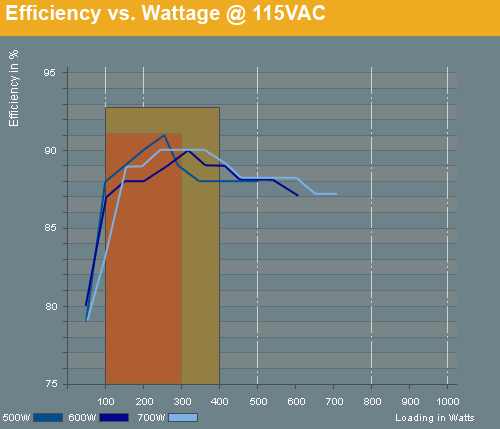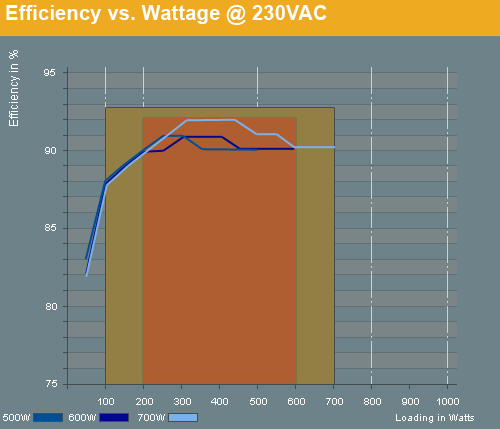Enermax Gold: Modu87+ and Pro87+
by Christoph Katzer on January 19, 2010 1:00 PM EST- Posted in
- Cases/Cooling/PSUs
Efficiency Comparison and How to Choose Your PSU
We wanted to explain to you how much power your system should actually use so you can make the best use of your new power supply. Of course you can load these power supplies up to the limit and still have around 87% efficiency - a result that many cheaper power supplies cannot reach even at their ideal load. However, these graphs show you where these power supplies reach their best efficiency.

From 100 to around 400W you will get maximum efficiency if you're on a 115VAC grid. That will provide you with an 88-91-88-percent curve with the 500W unit, an 87-90-89-percent curve with the 600W unit, and an 83-90-89-percent curve with the 700W unit. If you want even better efficiency you would want to be in the darker red area of 100 to 300W output. We've combined all three PSUs on one chart, however, so you will want to consider the curves and adjust your PSU selection as appropriate, e.g. the 700W PSU performs best with a load of at least 150W.

With 230VAC our recommendations look quite different. Users on a 230VAC grid can use any of these three units with any kind of load and achieve very good efficiency. Even at 5% load all of the units are still well above 80%, which is something that was difficult to reach a few years back. If you really want to squeeze the best results out of your units you will want load of at least 100W up to the maximum rated output of the PSU. That is a very large area and it shows how versatile these PSUs are. If your system uses 200W to 600W you will be able to maintain a constant efficiency of over 90%! In short, hook up just about any system to these power supplies on a 230V grid and you can be sure you'll be truly energy efficient.
Just to put things in perspective, the 80 Plus certification was introduced a few years back to put public focus on more energy efficient products, mainly power supplies. In the beginning there was only one certification, but since the initial introduction the group behind the certification has felt it necessary to introduce additional levels of efficiency. Today, we have Bronze, Silver, and Gold, with Gold being the highest level of the 80 Plus and presenting a very difficult target for the PSU manufacturers. The race to Gold has now been won, but now there's a new target in sight: Platinum. The required efficiencies for the different levels are listed below.
| 80 Plus Certification Requirements | |||
| 20% Load (Light) | 50% Load (Typical) | 100% Load (Full) | |
| 80 Plus Standard | 80% | 80% | 80% |
| 80 Plus Bronze | 82% | 85% | 82% |
| 80 Plus Silver | 85% | 88% | 85% |
| 80 Plus Gold | 87% | 90% | 87% |
| 80 Plus Platinum (230VAC only) | 90% | 94% | 91% |










59 Comments
View All Comments
nubie - Wednesday, January 20, 2010 - link
The only thing I learn from these reviews is to put in a 220v socket (USA) for the PC. It shouldn't cost much and would save on the power.I wonder what kind of efficiency you get from OEM PSU's (gateway, hp, dell) in the 250watt to 350watt range, because that is what I use to build PC's and I figure it puts them right in the middle of their power range with a 35-65watt CPU, as is common these days.
7Enigma - Thursday, January 21, 2010 - link
You sure the 220v US and the 230v Euro are compatible? I didn't think so but I'm not an electrician.As for the OEM PSU's I'd LOVE to see some tested. I'm banking on them being completely crap. More importantly than the efficiency would be the stability of these PSU's. Typically OEM's look for the least common denominator for all components, without normally sacrificing reliability when used as intended (ie not OC'd, extra devices).
But sounds like a great mini-review. Take a typical Dell, HP, Gateway (they still exist?) PSU and put them through the ringer and see who squeals first.
JonnyDough - Wednesday, January 20, 2010 - link
"we hope that Enermax will bring in some really good MIRs (mail-in rebates)"There is no such thing.
bigboxes - Wednesday, January 20, 2010 - link
I suppose it depends on the company. I got my Seasonic rebate in two months.JonnyDough - Thursday, January 21, 2010 - link
You're missing my point. What if you didn't get it? What if you had to cut off a UPC code, and a leg, and mail them in and then it took five months? Why can't they just give instant rebate at the checkout counter at Best Buy? Because they make money screwing people over. The discount only applies to those willing to mess around with the silliness of it all. Those who can't do it properly, lose out on it. Rebates are dumb.7Enigma - Thursday, January 21, 2010 - link
No, they make money by the majority of people not participating or participating improperly (forgot the UPC, sent in the wrong one, expired, etc.) Yes there are companies that are out to completely avoid paying rebates. They are the ones that have rediculously short windows for expiration, or just look for reasons not to pay (Tiger Direct....cough....cough). I've done a number of rebates my last 2 computer builds and have yet to not have one honored (most builds I give myself a 1 month window to accumulate all of the parts and heavily bank on the rebates to get better parts than I would otherwise purchase). One or two took significantly longer than stated, but in the end I received all of them WITHOUT having to contact the rebate company.Maybe I was just lucky, but maybe, just maybe I read the forms properly and sent in what was required within the allotted time.
Just one piece of advice if building a computer system. BUILD THE SYSTEM FIRST, THEN SEND IN THE REBATE. :)
cfaalm - Wednesday, January 20, 2010 - link
It can also be the Euro/Dollar rate (at 1.41 now) at work here. When this thing is manufactured in Germany the Dollar price is going to be outrageous compared to the Euro price.Then again, when I bought my MODU82+ 525 late december 2008 it cost me 100,00 Euro. They remain amongst the most expensive apparantly still.
JonnyDough - Wednesday, January 20, 2010 - link
I have an Enermax Liberty 500w and a Liberty 620w and they're both still going strong after several years.I'm really loving this Modu if there isn't anything better in a year or two when I finally upgrade my Opty 185 I may have to opt for this. It looks like its a bit easier to add/remove cables than my Liberty.
The gold fan is schweeeeet! At 140cm and with that blade design its gotta be darn near completely silent. Really great job Enermax. You're still my fave. :)
JonnyDough - Wednesday, January 20, 2010 - link
"Enermax will be modifying all of their PSUs to include the CordGuard function going forward, but we really don't think this is necessary."I do. Stupid cats.
Shadowmaster625 - Wednesday, January 20, 2010 - link
$150 for a power supply? Does it come with a glass pipe? Sheesh. What I'd like to see is a cheaper power supply that has a big fan like these, but only 300W. Only goofballs need more than 300 watts. I have a Q6600 system overclocked to 3.3 and it doesnt even pull 200 watts fully loaded. If I upgraded to a 5770 it should go to about 230 watts. So what is the deal with these 700W supplies?What I'd really like to see is a supply that outputs 50W at near 90% efficiency. Most new computers idle at 50 watts or less, and yet all these power supplies have atrocious efficiencies at that level. Not once have I ever read a review of a power supply that is actually specifically built & specced for 90% of the pc's that actually exist, ie those that idle around 50-75 watts and pull 120-150 fully loaded.